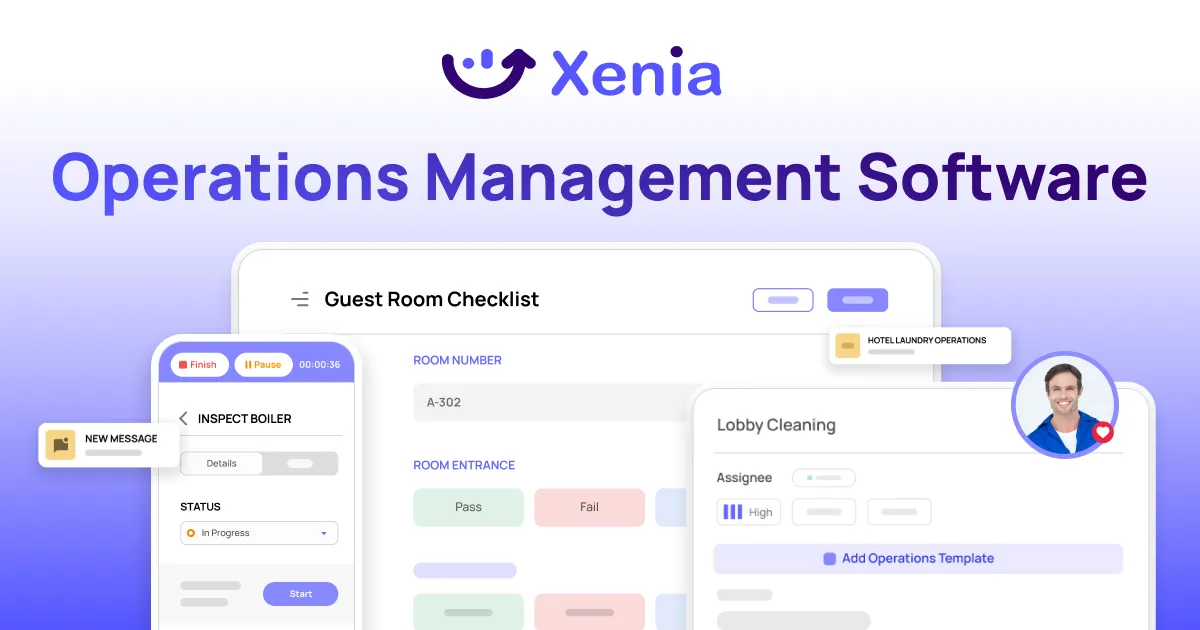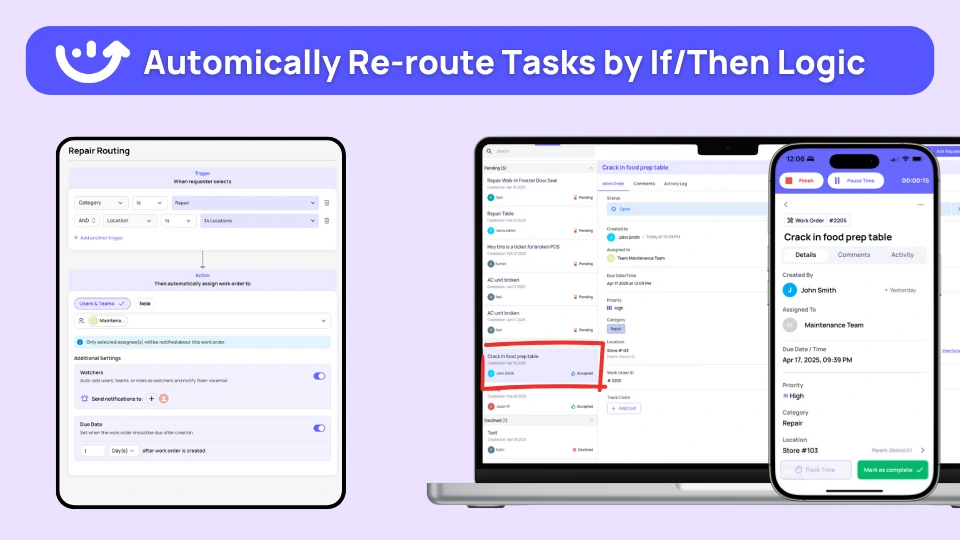The execution of operations at a mass level, day to day, is a messy business. When you are running tens (or even hundreds) of retail stores, restaurants, or convenience stores, it is even more challenging.
The bigger the footprint you leave, the more you are leaving yourself open to missing SOPs and a lack of assigned tasks, uneven standards, and siloed communications. And that is where the operations execution system is welcome. It is the force that progresses your plan in all of your departments, turns, and locations.
You may be scheduling a surprise health inspection or new product roll-out across all your 200 stores, or you simply would like to know that, indeed, those bathrooms are being cleaned at the prescribed times; an ops execution platform can turn your world around.
What, then, is operations execution? How must it ever so slightly vary concerning planning, and what types of operations execution software enable operations execution to scale across enterprise teams?
What is Operations Execution?
Operations execution is defined as the real-time coordination of tasks, SOPs, and communications, as well as the flows of the operations involved in the execution of the strategic plans. It assists each shift, each location, and each staff member to do the right things at the right time with the level of accountability entrenched in the working process.
Execution is the way or how, as strategy is the what, and planning is the when.
It is the system of record at the field level in making sure that:
- Store openings happen properly every morning.
- Safety checks are conducted and documented.
- Promotional signage is actually installed, not just assumed.
- Daily, weekly, and monthly SOPs are tracked with visual proof.
- Feedback loops between HQ and the field are closed.
Strategy vs. Execution vs. Logistics (Quick Breakdown)

What Tools Power Operations Execution?
You can’t scale execution with clipboards and email. Operations leaders today rely on a tech stack that brings frontline execution into the digital age, no guesswork, no paperwork, no micromanagement.
Here are the core categories of tools that support operations execution, with examples and use cases.
1. Digital Checklists (SOP Execution)
Consider daily open/close checklists, visual logs/logs of food safety, or walk-throughs of the store. These devices guarantee the work is completed, monitored, and accompanied by pictures and videos with a time stamp.
2. Shift & Task Scheduling Software
There are no structured schedules, and therefore, execution fails. These tools are used in the delegation, directing, and redirecting of tasks or shifts assigned depending on the role, place, or need.
3. Team Communication Apps (for Non-Desk Staff)
Frontline teams aren’t on Slack. They need mobile-first tools that support announcements, updates, and feedback without distraction.
4. Mobile Reporting Dashboards
Implementation without feedback is nothing. Real-time dashboards enable ops leaders to see what is being achieved, what is in arrears, and where performance is weakening.
5. Incident Logging & Corrective Action Workflows
Implementation involves repairing what is dysfunctional. Such tools make sure that in case of any failure, an incident is recorded, follow-ups are carried out, and closure is done.
6. Learning Management Systems (LMS)
Training is not a unilateral affair; it goes into execution. LMS tools make sure that your teams are aware of how to do SOPs before you want them to do them.
7. IoT Sensors & Real-Time Monitors
For industries like food service, cold storage, or retail asset tracking, execution often ties to environmental monitoring.
Top Operations Execution Systems for Retail and Enterprise Teams

Here’s a curated list of 7 operations execution software solutions that support real-time task management, SOP compliance, audit readiness, and mobile-first workflows, designed specifically for multi-location businesses.
.svg)


1. Xenia - #1 Operations Execution System

Best for: Multi-location businesses needing unified task management, SOP compliance, and issue tracking
Xenia is a single-point, all-in-one solution to execute operations; it is a platform aimed at streamlining business operations no matter what the sector.
Whether you’re operating retail chains of stores, a single convenience store, or enterprise services, Xenia can consolidate all your frontline activities, closing the gap between strategy and operation.
The platform will provide the teams with the tools to conduct their day-to-day activities perfectly, guarantee that all SOPs are adhered to, and provide real-time oversight on performance and compliance indicators.
Xenia allows managing your tasks, creating checklists, making audits, and reporting issues in one mobile-first device, eliminating the friction of disjointed systems and manual management, making your business run smoothly, consistently, and scalably.
Whether it is the C-suite or the store manager, all receive the information and control they require to perform perfectly on the floor.
Key Features
Smart Visual Checklists
Create custom checklists with live photo capture, digital signatures, and required inputs. Enforce completion standards with conditional logic (e.g., “If failed, take photo + add comment”). Set recurring schedules for inspections, health checks, and operational routines

SOP Library & Automation Workflows
Standardize all the processes of operation to arrive at a single location. Tie SOPs to work, tasks using AI, and checklists to make sure that they are followed step-by-step. Automate the workflows with rules that initiate a task, alert, or corrective measures by responding to the inputs.
Real-Time Dashboards & Audit Trails
Color-coded views of task statuses across all locations: completed, pending, overdue. Exportable PDF reports with embedded photos, timestamps, and notes for compliance audits. Monitor task execution by location, team, or role to identify performance trends

Advanced Task Assignment & Escalation
Assign tasks by role, user, or location with due dates and priority levels. Escalate missed or failed tasks automatically to the appropriate manager. Track task activity and completion in real-time from your desktop or mobile device

Issue Reporting with Proof & Follow-up
Log incidents or problems instantly with photos, videos, and detailed notes through issue reports and analytics. Trigger follow-up workflows or maintenance tickets based on issue type. Track resolution status and time-to-close to drive accountability
Offline Mode with Auto-Sync
Teams can complete tasks, checklists, and audits even without internet access. All activity syncs automatically once the device reconnects, so no data is lost
QR Code Task Launch
Place QR codes on equipment, rooms, or locations for instant task or checklist access. Workers simply scan the code to launch the correct workflow without needing to log in.

Pricing
Xenia offers flexible plans for growing and enterprise multi-location businesses.
- Premium: Advanced multi-site management with automations. Includes custom dashboards, automated corrective actions, equipment QR codes, work request routing, and premium support. Let’s chat about pricing.
- Enterprise: Individualized workflows and enhanced analytics of 10 + locations. Premium features+ Account manager dedicated, onboarding, integrations, template digitalisation, and add-ons such as SSO and temperature monitoring.
Contact Xenia to get a tailored quote based on your business size and needs.
.svg)

Priced on per user or per location basis
Available on iOS, Android and Web
2. MasterControl Inc.

Best for: Regulated industries needing an integrated Quality Management System (QMS)
MasterControl provides a closed-loop QMS system of life sciences and other highly compliance industries with document control, audits, CAPA, and supplier quality. It assists teams in adhering to compliance with regulations and faster time to market.
Key Features
- Cloud-based digital document control
- Change control and regulatory workflows
- Automated training management and tracking
Pricing
Request a quote from MasterControl.
3. MaintainX

Best for: Operations and maintenance teams needing asset and task visibility
MaintainX helps ops and maintenance teams execute preventive maintenance, inspections, and SOPs on mobile devices. It’s ideal for retail and facility operators managing daily workflows with rich task-level data.
Key Features
- Real-time work order and task tracking
- SOP-linked checklists and equipment QR scanning
- In-website chat/messages and break-time records
Pricing
Free basic plan; paid plans start at $16/user/month.
4. Squadle

Best for: HACCP and digital checklists, foodservice and C-store brands
Squadle digitizes back-of-house operations with IoT-integrated tools for temp monitoring, food safety compliance, and audit readiness. It’s designed for restaurant brands and C-store operations that need high-volume execution support.
Key Features
- Temp logging with probe integrations
- Checklists with visual confirmation
- Corrective workflows are triggered on failure
Pricing
Custom quotes available upon request.
5. MeazureUp

Best for: Franchises and field ops teams needing standardized location audits
MeazureUp powers franchise and enterprise-level audits with mobile-first forms, scoring logic, and performance reporting. It helps ops leaders ensure brand consistency and compliance across distributed locations.
Key Features
- Mobile field assessments with scoring
- Annotated photo capture
- Real-time insights and benchmarking dashboards
Pricing
Pricing varies by location count; request a demo for details.
6. OpsAnalitica

Best for: Ops teams that want deep audit reporting and operational intelligence
To manage decision-making, OpsAnalitica has a structure of checklists, automated warnings, and compliance analytics. It is commonly used by hospitality and foodservice companies that desire to have control over the day-to-day performance.
Key Features
- Dynamic checklists that adapt based on input
- Location scoring, alerting, and real-time dashboards
- Compliance analytics and exportable reports
Pricing
Quote-based pricing depending on business scale.
7. Lumiform

Best for: Teams seeking no-code checklist creation and inspection automation
Lumiform provides a competent platform to which teams can convert any paper process into an intelligent workflow. It can be applied to many industries, including safety audits, retail functions, and quality control. Its flexibility also means that the platform is particularly useful to business investors who want to get their inspections simplified, their processes normalized, and their compliance enhanced without the necessity of coding skills.
Key Features
- Drag-and-drop checklist builder with conditional logic
- Real-time task tracking, scoring, and reporting
- Digital signatures and mobile data capture
Pricing
Free plan available; business plans start at $19/user/month.
Tools That Actually Make It Work: Traditional Methods vs. Digital Platforms
Businesses continue facing certain traditional approaches in executing operations that once would have sufficed, but are currently not productive given the nature of operations that accompany growth. One should compare such obsolete solutions to digital platforms that offer real-time insights, automation, and more opportunities for controlling the process.
Traditional Methods
- Paper-based Checklists: Paper checklists are easy to misplace, and even lose, and do not give real-time information regarding what has been completed. Decentralization means that activities across locations cannot easily be monitored, resulting in inefficiency being realized.
- Manual Data Entry: Conventional techniques make use of manual data entry, which may cause human errors, inconsistencies, and delays in report generation. Such procedures also consume precious time, which could otherwise be utilized on other serious operations.
- Email Communication: Using email to overview the operational changes in different locations mostly results in loss of messages, timely response, and misunderstanding.
Digital Platforms (Xenia)
- Real-Time Task Assignment: Xenia enables the manager to delegate, monitor, and execute tasks in real-time at different sites. This reduces time wastage and delays, and also ensures jobs are legally finished in time.
- Automated Data Integration: Xenia makes all the information available on the same platform to minimize human error and guarantees that performance indicators, sales, and the status of the operations are prompt.
- Instant Communication: Using Xenia communication tools, managers will be able to update the staff with immediate notifications and reminders, and deliver the essential information without compromising its delivery to anyone. This makes it possible to do work properly and in a relevant fashion so that the places remain in line with the business objectives.
10 Best Practices to Improve Operations Execution
Achieving smooth operations entails assuring that all locations are on track and the consistency of the processes is uniform, with high standards. These 10 best practices will make your operations execution better, with some takeaways you can apply today in making your operations successful in every location.
1. Digitize Your SOPs and Daily Tasks
SOPs are slowly killing execution through paper. They are static, difficult to update, and simple to overlook. Modern execution system needs to capture your flows electronically, collate them into neat, interactive checklists that are live (they may change), and are receiptable (they can be completed). A QSR brand may turn its opening /closing checklist into digital equipment with obligatory photos and temperature records to keep an eye on.
2. Assign Tasks Based on Roles, Not Just People
Workflows should not be based on people but on roles. In such a way, when a person happens to be off or shifts, nothing can stop the process of execution. Auto-assignments can be done within the systems, such as Xenia, in terms of tasks to general roles such as a Shift Lead or a Facility Manager, rather than an individual. Automate the transition of tasks in a way that ensures important steps in the processes are not overlooked during the shift transitions.
3. Add Real-Time Visibility with Dashboards
Where execution is concerned, visibility is life and death. Without having to sift through 20 threads in Slack, managers must understand what has been done, what is late, and what is in the realm of the broken.
Work order requests that have incomplete items and flagged problems, and metrics should be displayed on the real-time dashboards. A local ops manager notices that checks on the restrooms at two stores are not being done and reminds them before a complaint is made to a customer.
4. Use Visual Proof to Lock In Accountability
Goodbye to “I did it, trust me”. All essential work, like checking equipment and installing merchandise, should be provided with visual evidence: a photo, notes, or dates. This way, you can transform a simple report into a source of truth. In the retail sector, live photos mean the layout of the stores complies with the HQ standards.
5. Build Smart Conditional Workflows
Fixed workflows fail to adjust in case of an error. The logical consequences must be conditional in case of task failure or when data exceeds certain thresholds, and this should cause subsequent actions to be flagged by managers or even open up a corrective action flow.
When a cooler reports temperatures above 40°F, Xenia can launch a workflow called a Food Safety Incident through a temperature and humidity sensor for freezers and refrigerators
and immediately notify the ops lead.
6. Simplify Communication with Embedded Messaging
No more using WhatsApp, post-it notes, or chats in the hallways. Each team possesses in-built communication such that the teams are able to comment, mention a supervisor, or record background without a platform changeover. Apply threaded discussions on checklist steps to make the troubleshoots visible to other future teams.
7. Automate Recurring Workflows
You do not need to make them forget to do a certain thing daily. Automating the routine is an easy way to forget something important (like performing daily checks, checking in to shift, or doing certificates compliance reports weekly). A checklist of HVAC filter inspections is automatically sent to the maintenance teams every Monday. No manual push required.
8. Connect Data to Action
Collect data to be action-oriented rather than audit-oriented. Your execution system must bring out trends (such as frequent failures or overdue completions) and enable managers to perform retraining or revise SOPs, respectively. A good safety management system would never pass on wet floor signs, time to huddle up with the team, or change the signs.
9. Tie Execution to Performance Reviews
You will need to attach KPIs to execution when you want people to attach importance to this factor. The amount of work completed, the punctuality, and the quality grades, these statistics all ought to be included in the tracking of performance, particularly that of team leads and store managers. Have scorecards at individual or team responsibility-Xenia dashboards can do these with ease.
10. Integrate Execution Into Onboarding & Training
Execution begins on Day 1. Embed your key workflows into onboarding so new hires not only know what to do, but also how to do it right, every time. Make execution a culture, not just a process. In a warehouse, new hires complete “First Week” SOPs that include safety briefings, machinery checks, and basic procedures, with a supervisor review.
Closing Thoughts
An operations execution system isn’t just a fancy checklist. It’s your blueprint for getting things done at scale, with precision, and without excuses. Whether you’re managing five stores or five departments, execution is the multiplier that turns strategy into ROI. And that’s exactly where tools like Xenia come in: real-time task tracking, visual audits, automated workflows, and performance dashboards, all under one roof.
By leveraging Xenia’s tools, businesses can reduce inefficiencies, eliminate errors, and scale with confidence. Ready to revolutionize your operations execution? Xenia is here to help you optimize operations and grow your business seamlessly.
👉 Want to see it in action?
Book a Demo and get operations done right.

.svg)
.webp)
%201%20(1).webp)


.webp)



.svg)
%201%20(2).webp)








